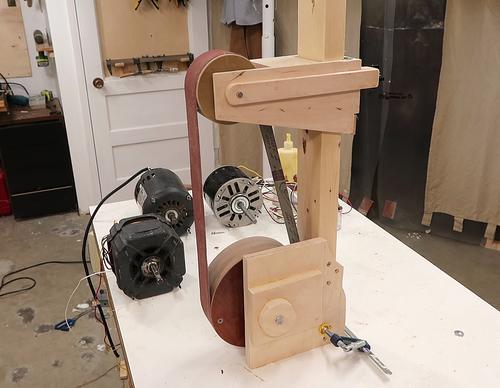
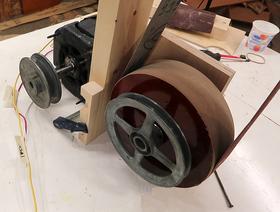 Having built the frame and pulleys for the belt grinder, the next step
was to add a motor.
Having built the frame and pulleys for the belt grinder, the next step
was to add a motor.

 Having built the frame and pulleys for the belt grinder, the next step
was to add a motor.
Having built the frame and pulleys for the belt grinder, the next step
was to add a motor.
My initial idea was to make some sort of shaft with two universal joints to couple the motor to the lower wheel. But it turned out, the motors I wanted to use rotated clockwise (when looking at the shaft), and weren't reversible.
I briefly considered putting the motor behind the sander, with two pulleys. This would allow me to change the speed, but would also mean removing the drive belt to remove the sanding belt.
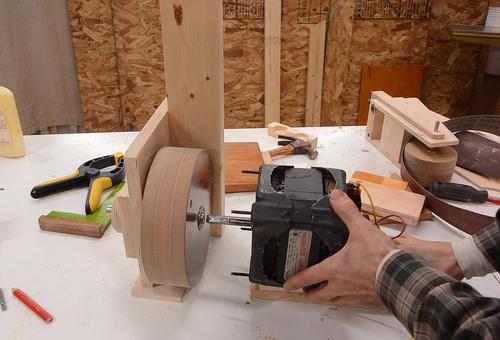 It was much easier to just put the lower wheel mount on the other side
to fix the direction problem.
It was much easier to just put the lower wheel mount on the other side
to fix the direction problem.
I decided to use this old washer motor, which has the feature of being able to run at 1750 and 1150 RPM (it has 4-pole and 6-pole windings).
To get the motor closer to the wheel, I figured some semi-flexible coupling would make more sense.
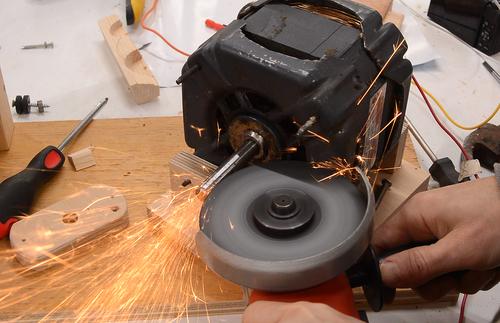
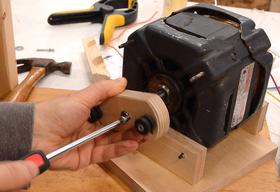 The shaft has a flat spot for where the pulley mounts, but I wanted more
of a key slot, so I used an angle grinder to hollow it out a bit.
The shaft has a flat spot for where the pulley mounts, but I wanted more
of a key slot, so I used an angle grinder to hollow it out a bit.
I made a yoke to fit on the shaft. I cut a key notch on one side of the hole with a jigsaw. A wood screw serves as the key. The nice thing about using a screw as a key is that it really locks the yoke in place, yet is easy to remove by unscrewing it.
You can also see the motor mount I'm making. A block attached to the studs sticking out of the front of the motor, and another block screwed to the back of the motor.
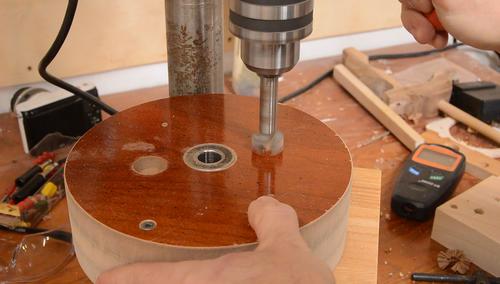
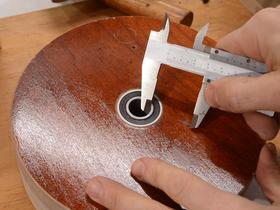 The yoke has two big rubber grommets mounted to it to engage with
holes in the lower wheel. Precision is very critical for this sort
of thing, so I was very careful laying it out, then drilling the holes.
The yoke has two big rubber grommets mounted to it to engage with
holes in the lower wheel. Precision is very critical for this sort
of thing, so I was very careful laying it out, then drilling the holes.
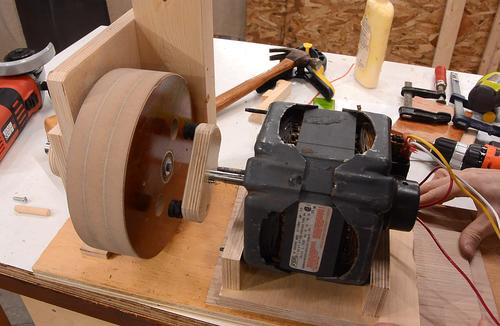 Pushing the motor forward to engage the holes in the lower wheel.
Pushing the motor forward to engage the holes in the lower wheel.
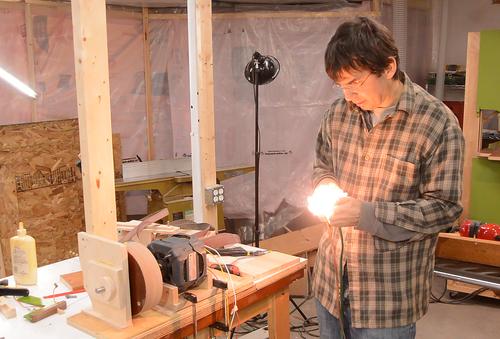 Plugging it in for the first time. Kaboom!
Plugging it in for the first time. Kaboom!
I had reverse engineered how this motor is wired up and tested it before, but I took some of the connectors off the motor and put them back (incorrectly, it turns out) when I made the motor mounts.
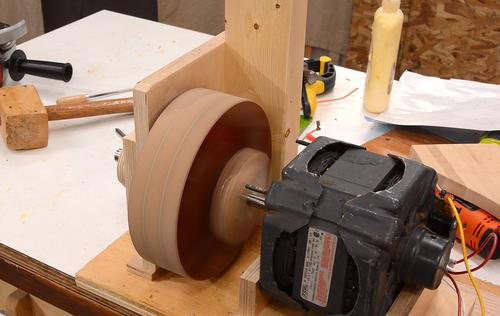 Wiring fixed, motor spinning the lower wheel. There was quite a bit of
vibration if the motor was even slightly out of alignment.
Wiring fixed, motor spinning the lower wheel. There was quite a bit of
vibration if the motor was even slightly out of alignment.
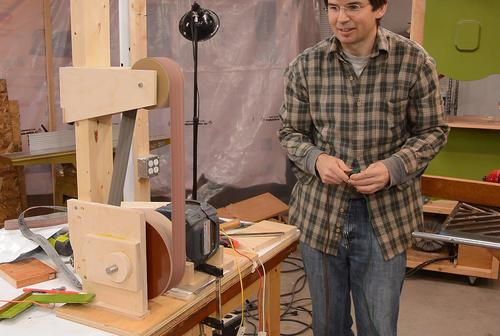 Testing some more, now with a 2x48" sanding belt in place and running
at the high speed. It ran quite smooth.
Testing some more, now with a 2x48" sanding belt in place and running
at the high speed. It ran quite smooth.
In fact, the motor runs smoother and quieter at the higher speed.
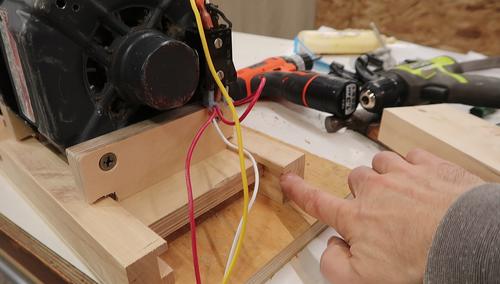 I made two C-shaped rails for the motor's base to slide forward and back
in for easier engaging and disengaging it. The motor has to disengage
the lower wheel when changing sanding belts.
I made two C-shaped rails for the motor's base to slide forward and back
in for easier engaging and disengaging it. The motor has to disengage
the lower wheel when changing sanding belts.
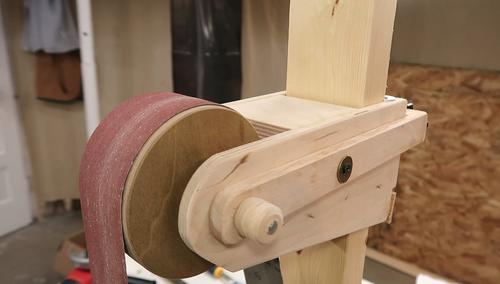 I also ended up refining the mount for the idler wheel, cutting the
mounts round and sanding the edges. There is a knob in the back
that pushes the long piece forward, which pushes the shaft
forwards and up in a slot for making tracking adjustments.
I also added a knob to the end of the shaft to make it easier to pull
out (for belt changes).
I also ended up refining the mount for the idler wheel, cutting the
mounts round and sanding the edges. There is a knob in the back
that pushes the long piece forward, which pushes the shaft
forwards and up in a slot for making tracking adjustments.
I also added a knob to the end of the shaft to make it easier to pull
out (for belt changes).
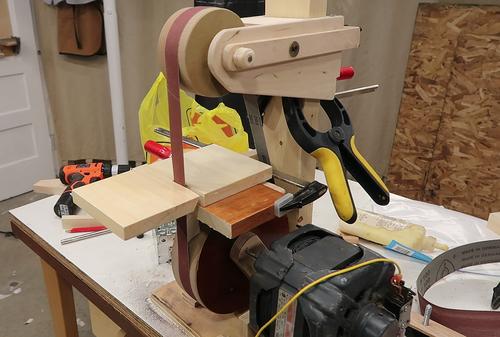 Now with a 1x42" sanding belt. I clamped a piece of wood
in place to figure out how to mount the table, which needs to be able
to tilt. I also have to figure
out how to make a housing for it and how dust collection will work.
Much to think about.
Now with a 1x42" sanding belt. I clamped a piece of wood
in place to figure out how to mount the table, which needs to be able
to tilt. I also have to figure
out how to make a housing for it and how dust collection will work.
Much to think about.
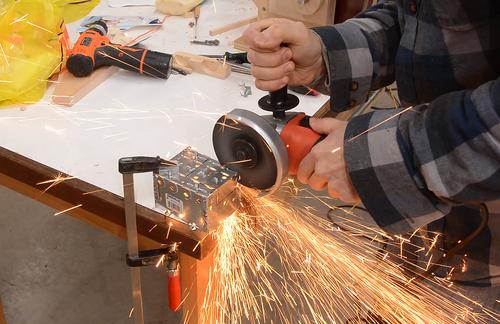
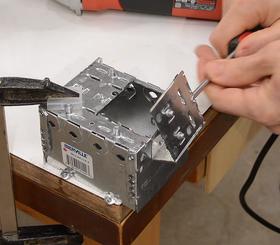 So for now I figured I'd work on the electrical part of it. I took an
electrical box large enough for two switches and cut a chunk out the
back of it so it would fit around the back of the motor.
So for now I figured I'd work on the electrical part of it. I took an
electrical box large enough for two switches and cut a chunk out the
back of it so it would fit around the back of the motor.
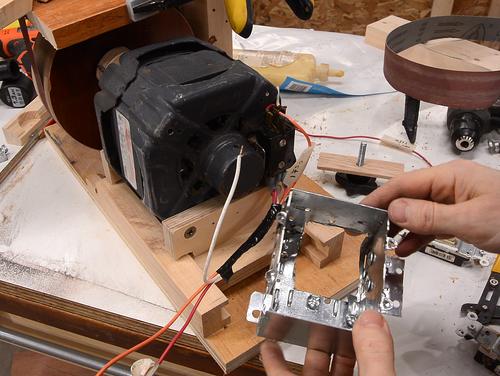 I made some mounting flanges for this box to mount it to the
back of the motor.
I made some mounting flanges for this box to mount it to the
back of the motor.
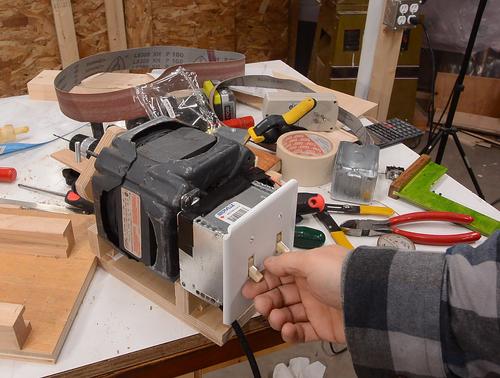 Box installed. The left switch is on/off, the right switch is a 2-way
light switch (an SPDT type switch) to select between the 1750 RPM and 1250 RPM
windings.
Box installed. The left switch is on/off, the right switch is a 2-way
light switch (an SPDT type switch) to select between the 1750 RPM and 1250 RPM
windings.
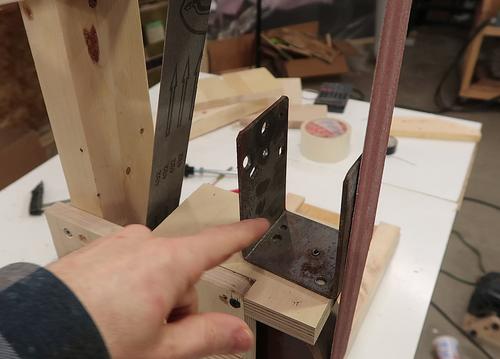 Now back to the rest of the sander. I needed some platen to go behind
the belt, and this bracket was just the right shape to make that out of.
Now back to the rest of the sander. I needed some platen to go behind
the belt, and this bracket was just the right shape to make that out of.
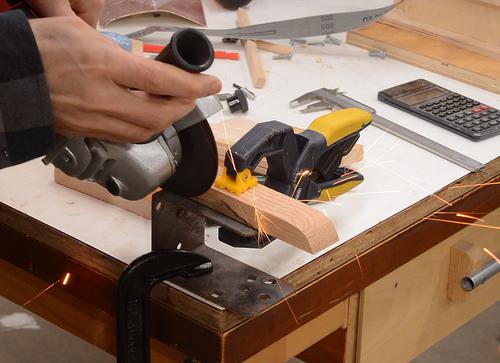 I clamped a piece of hardwood to it to act as a guide for cutting it to
the right width with an angle grinder.
I clamped a piece of hardwood to it to act as a guide for cutting it to
the right width with an angle grinder.
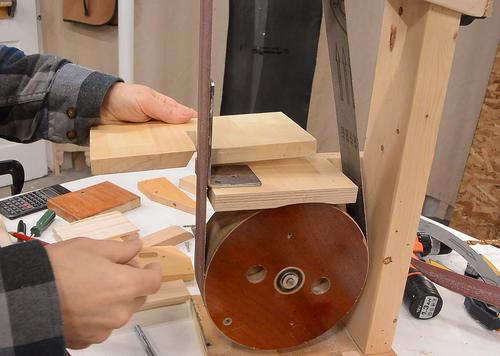 Then trying out how the table should fit around that (the "table" is
just a piece of scrap with a slot cut in it to test the fit).
Then trying out how the table should fit around that (the "table" is
just a piece of scrap with a slot cut in it to test the fit).
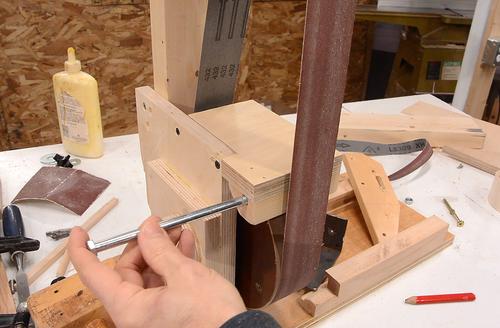
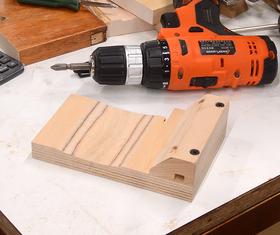 I made a mount to hold a bolt for clamping the table. The bolt fits
under the table mount.
I made a mount to hold a bolt for clamping the table. The bolt fits
under the table mount.
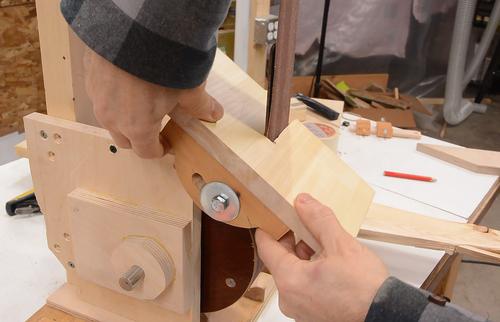 Then I made a bracket to fit to the bottom of the table to see how that
would work out.
Then I made a bracket to fit to the bottom of the table to see how that
would work out.
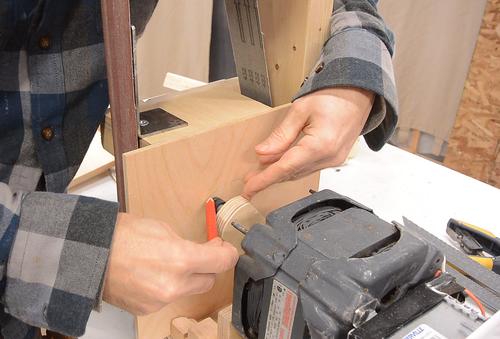
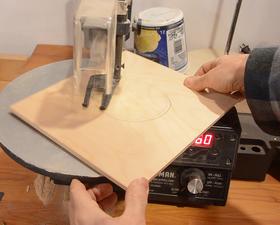 Before proceeding any further with the table, I figured I should make
the enclosure for dust collection.
Before proceeding any further with the table, I figured I should make
the enclosure for dust collection.
A panel will go on the right side, but it needs to have a hole big enough for the yoke to fit through. I used the yoke itself to mark the circle, then cut that out with a scroll saw.
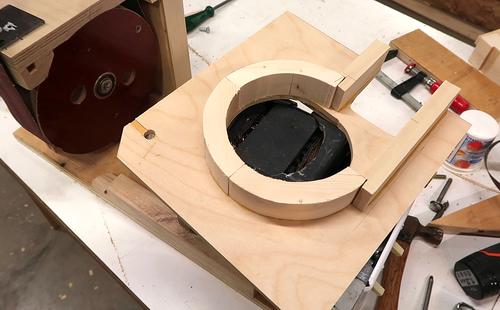 Next I cut some pieces and glued them on to make a round housing for the
yoke, plus a channel for where the dust collector will hook up.
Next I cut some pieces and glued them on to make a round housing for the
yoke, plus a channel for where the dust collector will hook up.
The shape of this looks a bit like it could be a blower, but at these low RPMS and small diameter it really would not be effective enough to be worthwhile.
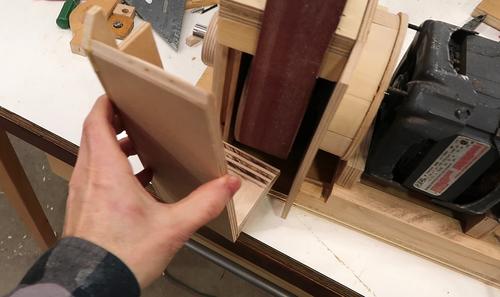 I made another part of the housing to go on the front (for sander mode).
I made another part of the housing to go on the front (for sander mode).
Also, I made a panel to fit on the front of the motor which closes off the panel at right when the motor is in place.
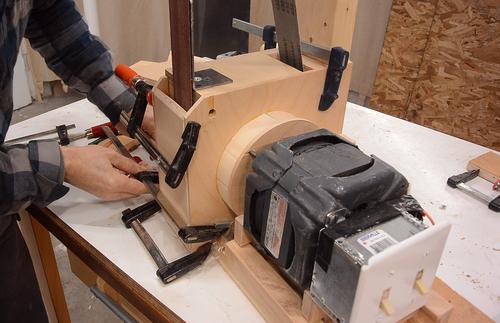 I glued the two pieces of housing together while on the sander to make
sure it would fit.
I glued the two pieces of housing together while on the sander to make
sure it would fit.
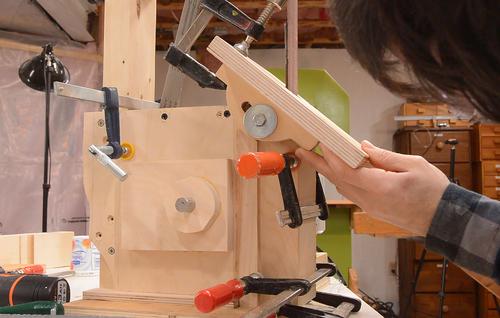 While the glue was drying, I went back to working on the table.
While the glue was drying, I went back to working on the table.
I cut a proper table and mounting bracket out of Baltic birch plywood, then clamped those two together and checked the fit to make sure the mounting bracket was in the right place.
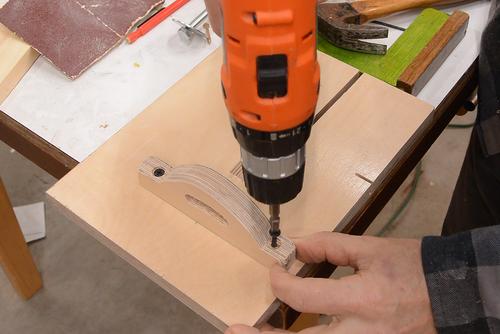 Then screwed on the bracket (with holes, countersinks, and pilot holes
drilled, though I didn't film or photograph those steps).
Then screwed on the bracket (with holes, countersinks, and pilot holes
drilled, though I didn't film or photograph those steps).
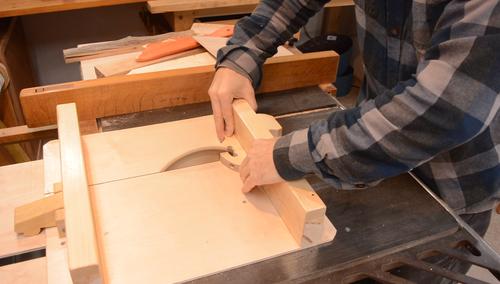 I wanted another bracket like that to go on the other side, but
the belt needed to pass through there, so I cut the bracket in half.
I wanted another bracket like that to go on the other side, but
the belt needed to pass through there, so I cut the bracket in half.
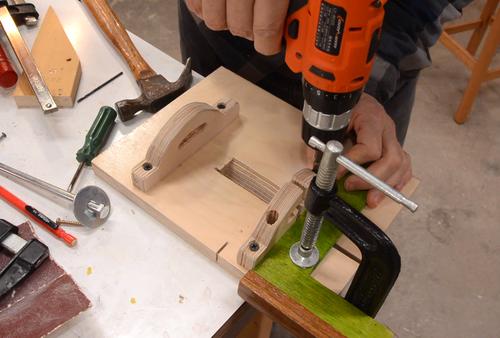 Fitting it on the sander, I worked out where it needed to go
and screwed it on. This one has two screws in each half so the pieces
can't twist out of position.
Fitting it on the sander, I worked out where it needed to go
and screwed it on. This one has two screws in each half so the pieces
can't twist out of position.
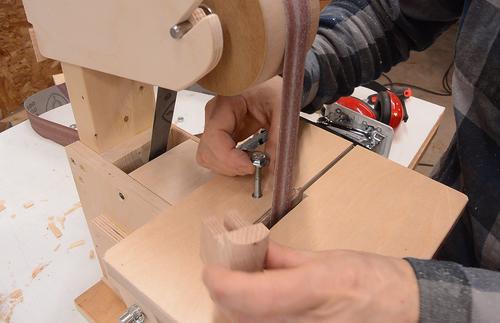
 I also added a threaded insert to the table just behind the belt.
This will make it easier to mount temporary platens, like this curved
one for sanding inside round curves.
I also added a threaded insert to the table just behind the belt.
This will make it easier to mount temporary platens, like this curved
one for sanding inside round curves.
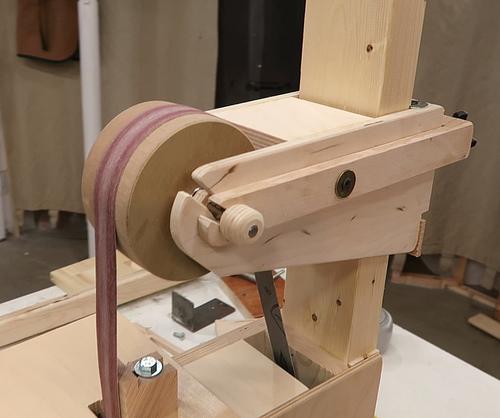 I also cut a slot in the upper wheel mounts so that it's easier to take
the upper wheel out when changing belts. Previously, I had to pull
the axle out, but lining that up, with spacers on either side, when putting
the belt back on was kind of annoying.
I also cut a slot in the upper wheel mounts so that it's easier to take
the upper wheel out when changing belts. Previously, I had to pull
the axle out, but lining that up, with spacers on either side, when putting
the belt back on was kind of annoying.
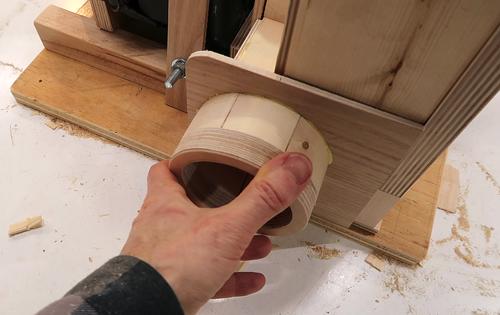 I also made a hookup for the dust port on the back. Just a 4" (10 cm)
wooden pipe. It really doesn't need one that big, but a 4" plastic vent
hose hose is quite flexible, so might as well use one of those.
Those hoses are very flimsy, but cheap, so just right for this application.
I also made a hookup for the dust port on the back. Just a 4" (10 cm)
wooden pipe. It really doesn't need one that big, but a 4" plastic vent
hose hose is quite flexible, so might as well use one of those.
Those hoses are very flimsy, but cheap, so just right for this application.
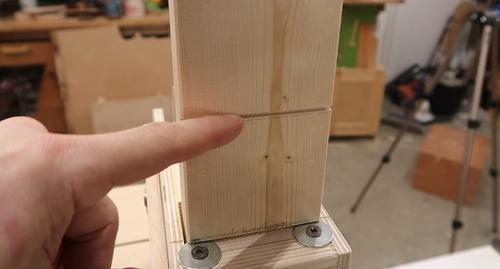 And I cut more slots in the back of the column to hook the upper
wheel mount onto for different belt lengths. One for 42", one for 48"
and one for 72" long belts.
I also have a threaded insert for each position to lock and tighten it.
And I cut more slots in the back of the column to hook the upper
wheel mount onto for different belt lengths. One for 42", one for 48"
and one for 72" long belts.
I also have a threaded insert for each position to lock and tighten it.
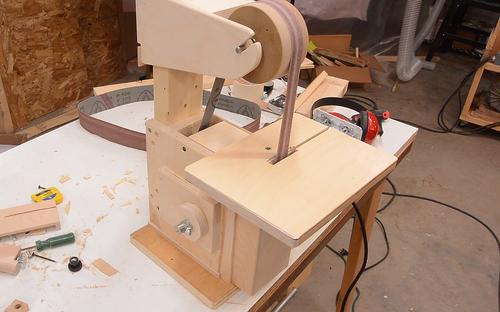 With enclosure and a 1x42" belt installed, it looks more like a strip sander.
With enclosure and a 1x42" belt installed, it looks more like a strip sander.
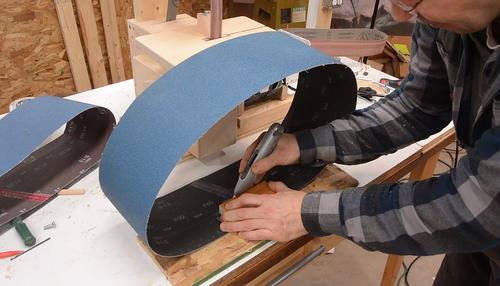 Unfortunately, I could not find any 2x72" grinding belts locally, and the ones
I ordered still have not arrived. But I found some 6x48" belts, so
here I'm cutting one of those into 2" strips, using a little guide to help
me run the knife 2" from the edge.
Unfortunately, I could not find any 2x72" grinding belts locally, and the ones
I ordered still have not arrived. But I found some 6x48" belts, so
here I'm cutting one of those into 2" strips, using a little guide to help
me run the knife 2" from the edge.
When I'm done with a 6x48" wood sanding belt on my belt sander there is usually at least one edge that is still good, so I will probably cut maybe 1.5" off the side of the belt to use on this sander.
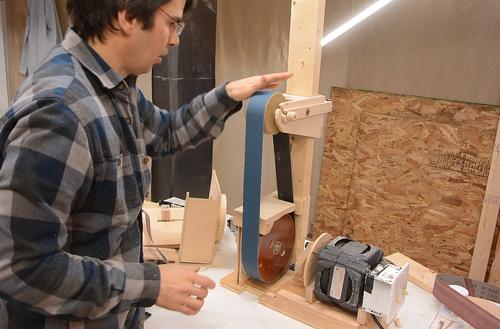 Metal grinding belt mounted without the dust cover. Lots of sparks inside
a tight wooden housing would probably be a bad idea.
Metal grinding belt mounted without the dust cover. Lots of sparks inside
a tight wooden housing would probably be a bad idea.
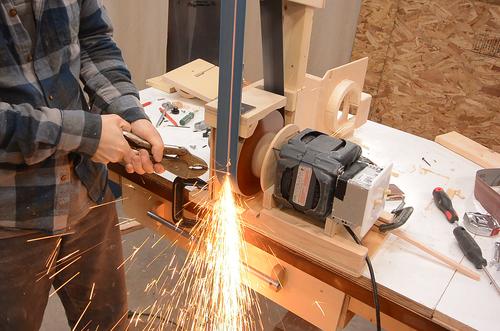 And testing it. Grinding against the wheel, I was able to grind away most
of a drywall screw in just five seconds. So even a 1/2 hp motor appears
to be adequate for my hobby uses.
And testing it. Grinding against the wheel, I was able to grind away most
of a drywall screw in just five seconds. So even a 1/2 hp motor appears
to be adequate for my hobby uses.
That said, grinding drywall screws into oblivion is one of the more satisfying things to do. The high carbon steel makes for a LOT of sparks, and the screw gets red hot very quickly, at which point, it's soft to grind regardless of how much carbon the steel has.
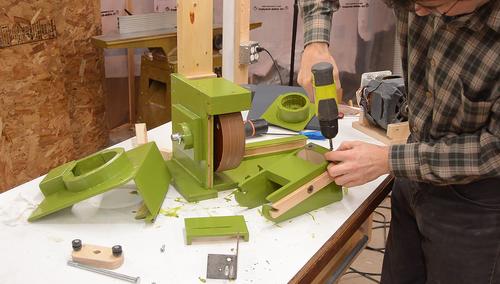 I figured it was ready for some green paint, so I took it all apart, varnished
some pieces and painted the rest, then reassembled it.
I figured it was ready for some green paint, so I took it all apart, varnished
some pieces and painted the rest, then reassembled it.
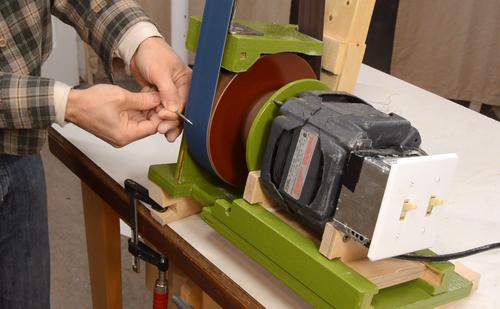 I also made two wedges to go under it to make it easier to use when grinding.
I may end up laying the whole sander on its back for some operations.
I also made two wedges to go under it to make it easier to use when grinding.
I may end up laying the whole sander on its back for some operations.
But I don't know what I will use this sander as most. I kind of like the idea of having a really beefy strip sander, and I could use a strip sander for the basement workshop. I have the little 1x30" sander from Canadian Tire there now (the homemade strip sander is in the main workshop), but I don't like the 1x30 sander much anymore. It runs too fast, rattles a alot and spews dust everywhere.
That said, I still need a dedicated dust collector for this one, similar to the one for my belt sander. One small one for each machine so I don't have to open and close blast gates all the time.
Update 2021
I built that sander in 2018, with the intention that it could be used a belt grinder and as a wood belt sander. But as a wood belt sander it has a serious flaw. The lower wheel is much larger than the top wheel, so it's less effective at flinging dust that sticks to the belt off. So even with dust collection sucking away dust from the bottom, quite a lot of dust gets flung off the belt when it goes over the top wheel. So I don't use it for wood. But I liked the idea of a bigger belt on a strip sander, so in 2020 I built my strip sander xl which uses a 1.5" x 48" belt.
As a belt grinder, it's not as good as normal belt grinders, but it was easier to build and doesn't take up much workbench space. It wouldn't be smart to use a belt grinder all enclosed in wood, so I don't use the enclosure. And the metal dust doesn't stick to the belt like wood dust does, so the lower wheel being bigger isn't an issue as a belt grinder.
The way the motor is coupled to the lower wheel is complicated. I should have just mounted the lower wheel directly to the motor shaft. And it's because of these flaws that I never drew a set of plans for it. A belt grinder is a metal working tools, and metal workers prefer to make their tools out of metal, naturally.
At the end of the video, and in the last picture above, I'm grinding a sharp point on a long nail. On a whim, I later made a handle for that to use it as an awl, and painted it green. That awl is one of the ones I show here making fun of the Jimmy Diresta ice pick.